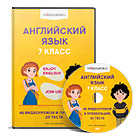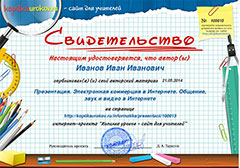Lesson Plan
Theme: “Shopping”
Aims of the lesson: Students will be able to use and understand common expressions related to shopping
Educational: To give a short presentation about different types of shops
Practical: to develop reading, writing, listening and speaking abilities; to enlarge their outlook
Cultural: to encourage the motivation to learning English
Visual aids: active board, presentation, shopping sheets
Used technologies: Critical thinking, project
Procedure
- Organization moment: Greeting
T: Good day, students. I’m glad to see you!
Ps: Good day, teacher. And we are glad to see you, too!
- Going over the homework
Students have to give information about their villages
They should make a map of their villages
- Presentation
Working with vocabulary
Teacher gives some words; students have to guess with what word are given words connected with.
Money, cheap, expensive, food, clothes, buy, sell, cost.
Department stores
The students will talk about department store before learning more about shopping.
What kind of shops do you know?
SHOPS
Answer the questions
What can you buy at the bakery?
What can you buy at the grocery?
What can you buy at the greengrocer’s?
What can you buy at the florist’s?
What can you buy at the shoe shop?
What can you buy at the newsagent’s?
What can you buy at the toy shop?
What can you buy at the chemist’s?
What can you buy at the record shop?
What can you buy at the jeweler’s?
What can you buy at the confectionery?
Sort the words into the right boxes. Here is the shopping list.
Pear, sweets, paracetamol, tea, salt, onion, coffee, radishes, lamb, grape, sugar, beef, cough mixture, ham, antiseptic cream, raspberry, pork, mushrooms, cauliflower, tangerine, bacon, coffee, cornflakes, eggs, dill, cake, marmalade, bandage, iodine.
Students of each team have to choose the shop where they’ll go and make another list for shopping.
Listening
Students have to listen to the dialogue and fill in the missed words
in the sheet
- Good morning.
- Good morning.
- How can I help you?
- I’d like some ………., please.
- Er… sorry. There’s orange juice, but no apple juice.
- Then give me …………., please.
- A …… like this?
- Yes, fine. What about some coffee?
- Yes. There you are.
- What else? Oh! I need a French …….and ……. of milk.
-Here you are! Would you like …….?
- No, thank you. That’s all. How much?
Working with the text
The given text will be divided into 4 parts by the method zigzag. Each team will translate and discuss its paragraph
Shopping in Great Britain
Britain’s favorite store. Tourists love it too. It attracts a great variety of customers from house wives to millionaires. Princess Diana, Dustin Hoffman and the British Prime-minister are just a few of its famous customers. Last year it made a profit of 529 million pounds, which is more than 10 million a week.
It all started 105 years ago when a young Polish immigrant Michael Marks had a stall in Leeds market. He didn't have many things to sell: some cotton, a little wool, lots of buttons and a few shoelaces. Above his stall he put the now famous notice: "Don't ask how much - it's a penny." Ten years later he met Tom Spencer and together they started Penny stalls in many towns in the North of England. Today there are 564 branches of Marks & Spencer all over the world: in America, Canada, Spain, France, Belgium and Hungary.
The store bases its business on 3 principles: good price, good quality and good service. Also, it changes with the times; once it was all jumpers and knickers. Now it sells food, furniture and flowers as well. Top fashion designers advice on styles of clothes. Perhaps, the most important key to its success is its happy well-trained staff. Conditions of work are excellent. There are company doctors, dentists, hairdressers, etc. And all the staff can have lunch for less than 40 pence.
Shopping in Britain is also famous for its Fresh food. Fresh food is a chain of food stores and very successful supermarkets which has grown tremendously in the twenty years since it was founded, and now it has branches in the High Streets of all the towns of any size in Britain. In the beginning the stores sold only foodstuffs, but in recent years they have diversified enormously and now sell clothes, books, records, electrical and domestic equipment.
«Thin and thick questions»
After reading the text students have to put questions on another team’s paragraph
4. Practice
Make up a dialogue
Each team chooses the theme for their dialogue and acts it.
Remind students that it would be unnatural to use too many idioms all in one go. However, for the purposes of learning idioms effectively, it can be useful to learn them as a lexical set.
1. to shop around H. to look for the best price
2. to shop until you drop G. to go shopping until you are so tired you
can’t carry on
3. to talk shop A. to discuss work issues in your free time
4. to go window shopping F. to look around the shops but buy nothing
(You could also teach ‘to browse’)
5. to shoplift I. to steal something from a shop
6. to shop someone B. to tell the police that someone has committed a crime
7. to be all over the shop C. to be disorganized and confused
8. to be like a bull in a china D. to rush around and knock things over shop
9. to go on a shopping spree E. to buy many things (often without thinking too
much about the cost)
- What can you say about….?»
Students have to choose one number from 1 till 15, under each number there is a question on which they should answer.
1
What makes an advertisement successful?
2
Who do you usually go shopping with? Why?
3
Do you prefer going shopping alone? Why?
4
What is your favorite shop? Why?
5
What do you spend your money on? Why?
6
Have you ever made a complaint in a shop? Why?
7
Do you buy lottery tickets? Why?
8
What kind of shops do you visit most often and why?
9
Do you like shopping? Why?
10
Tell me a situation when you were bored in a shop?
11
Do you buy in second –hand shops? Why?
12
How often do you shop online and why?
13
What are the best things to save money?
14
Do you think being a shop assistant is a hard work? Why?
- Conclusion
Giving the home task
- Learn new words by heart
- Write an essay about shopping in your village
























